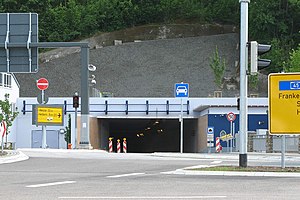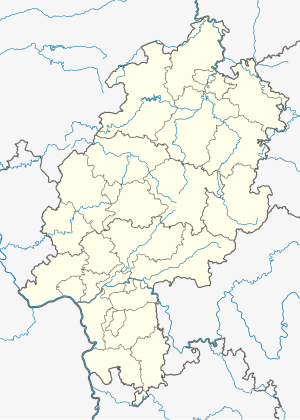Schlossberg tunnel Dillenburg
| Schlossberg tunnel Dillenburg | ||
|---|---|---|
|
North portal
|
||
| use | Road tunnel | |
| traffic connection | B277 | |
| place | Dillenburg (Hesse) | |
| length | 782 m | |
| Number of tubes | 1 (+ escape tunnel) | |
| construction | ||
| Client | Federal Ministry of Transport, Building and Housing | |
| building-costs | 44 million euros | |
| start of building | 2003 | |
| completion | October 2007 | |
| business | ||
| operator | Federal Ministry of Transport, Building and Housing | |
| toll | No | |
| release | October 2007 | |
| location | ||
|
|
||
| Coordinates | ||
| North portal | 50 ° 44'25 " N , 8 ° 16'54" E | |
| South portal | 50 ° 44 ′ 13 ″ N , 8 ° 17 ′ 22 ″ E | |
The Schlossberg tunnel Dillenburg is a 782 m long road tunnel in Dillenburg ( Lahn-Dill district , Hesse ) as part of the Dillenburg bypass on the B277 . It was completed in April 2007. The construction costs were around 44 million euros.
Traffic significance
The B 277 connects Dillenburg with the cities of Haiger and Herborn . The B 277 has two lanes between the Dillenburg junction of the federal motorway 45 and the entrance to Dillenburg . Until the tunnel was built, the B 277 ran on a two-lane city road through Dillenburg. The traffic load forecast for 2015 was almost 30,000 vehicles / day, of which around 60% were through traffic . Between the Dillenburg exit and the Herborn-Süd junction with the BAB 45, the B 277 has again been expanded to two lanes.
Coming from Haiger, the new B 277 now crosses the Dill at the entrance to the village , for which a new Dill bridge was built. Then it runs through the tunnel under the Schlossberg. At the exit towards Herborn, the tunnel was reconnected to the existing B 277.
The Schlossberg tunnel has a continuous tube 782 m long. It was planned for a forecast traffic load of 18,000 vehicles per day. The width of the lane is 7.5 m, the clear height 4.5 m. There are breakdown bays on both sides roughly in the middle of the tunnel. For safety reasons, an escape tunnel 550 m in length was built next to the main tube. The tunnel is connected to the escape tunnel by three marked cross passages.
Geology and hydrology
Haiger from the tunnel rock layers from oberdevonischem crosses slate with sandstone interlayers , diabase with Alaunschieferzwischenlagen , diabase with Spilit, slate, greenstone and loamy gravel. As the entire length of the tunnel is below the water table, it had to be expanded as a pressurized water-retaining system. For this purpose, it was sealed with a three millimeter thick film and a water-impermeable concrete structure was made.
Planning history
Planning approaches for a bypass in Dillenburg go back to the 1950s. With a letter on June 24, 1957, the city of Dillenburg encouraged the planning work for the town passage . The route of the B 277 through the narrow Dill valley with its flanking mountain slopes and the narrow historical buildings were particular problems in planning. In the 1970s a traffic concept was drawn up that provided for a partial overbuilding of the Dill. Alternatively, an elevated road was planned. However, these drafts failed in the planning approval .
On February 14, 1985, the city council decided to build a tunnel under the Schlossberg. In 1987 the Dillenburg Casemates , one of the largest underground defenses in Germany, were measured as part of the planning . In 1997 a new plan approval procedure was initiated. The building rights were created with the planning approval decision of September 20, 2002.
security concept
During the planning approval procedure, there was a fire disaster in the Mont Blanc tunnel , which triggered a Europe-wide discussion about the safety of road tunnels. As a result, an extended safety concept was developed for the Dillenburg Schlossberg tunnel.
The tunnel has a powerful extraction system that can convey 180 m³ of air per second. A special 72 m long exhaust air tunnel was created for the extraction system. There are emergency call stations every 150 m in the tunnel . The tunnel is also monitored by 37 video cameras. Road users can be informed via loudspeakers. 7 ultra-short wave transmitters were installed in the tunnel to send traffic reports and messages directly to the car radios. A traffic control system is able to automatically block the tunnel in the event of a disaster.
The tunnel is controlled fully automatically from the operations center at the north portal. The operations center is only manned when the fire brigade and rescue services are deployed. It has an uninterruptible power supply that is able to supply the safety-relevant systems for up to an hour. The operations center of the tunnel is directly connected to the central fire brigade control center of the Lahn-Dill district. At the same time, the reports from the operating facilities are transmitted to the tunnel control center of the State of Hesse in Eschwege , which centrally monitors all Hessian road tunnels.
Construction process
As a preparatory measure for the tunnel construction it was necessary to demolish individual buildings. This also included the building of the Dillenburg police, the gym of the Dillenburg Johann von Nassau school and the building of the former Ciliox KG. A new building was built for the police on Hindenburgstrasse.
The first groundbreaking as the symbolic beginning of the construction of the bypass took place on April 24, 2003, the official tunnel construction on April 20, 2004. The tunnel inauguration weekend took place from April 27 to 29, 2007.
Walter Bau AG was commissioned as general contractor with the construction work . Due to their bankruptcy on February 2, 2005, work was interrupted. On July 1, 2005, the construction work was completed by DYWIDAG Bau GmbH, which is part of the STRABAG SE Group.
Around 150,000 m³ of excavated and demolished material had to be moved for the construction of the tunnel. A concrete mixing plant was built for the 39,000 m³ of concrete required . Furthermore, 3,000 tons of reinforcing steel were used.
The tunnel was built in three structural sections: 30 m from the north portal using the cut-and-cover method, then 615 m using the mining method and 137 m to the south portal using the cut-type construction. This is followed by a 151 m long trough section to protect against the dill flood. The escape tunnel was built using mining techniques. In the area of mining construction, the entire excavation was carried out in three partial excavations ( crown , stope , base vault ). Depending on the geological conditions, a depth of 0.8 m to 1.5 m was reached with each blast. The exposed mountain areas were supported with an outer shell made of shotcrete . This was sealed with a foil, then the construction of the inner shell followed. A smoke evacuation channel was created by pulling in a false ceiling.
literature
- Dillenburg Office for Roads and Transport: Schlossbergtunnel Dillenburg - (Brochure on traffic approval), April 2007
Web links
- Schlossberg tunnel at structurae.de
- Information page of the project ( Memento from December 18, 2014 in the Internet Archive )



